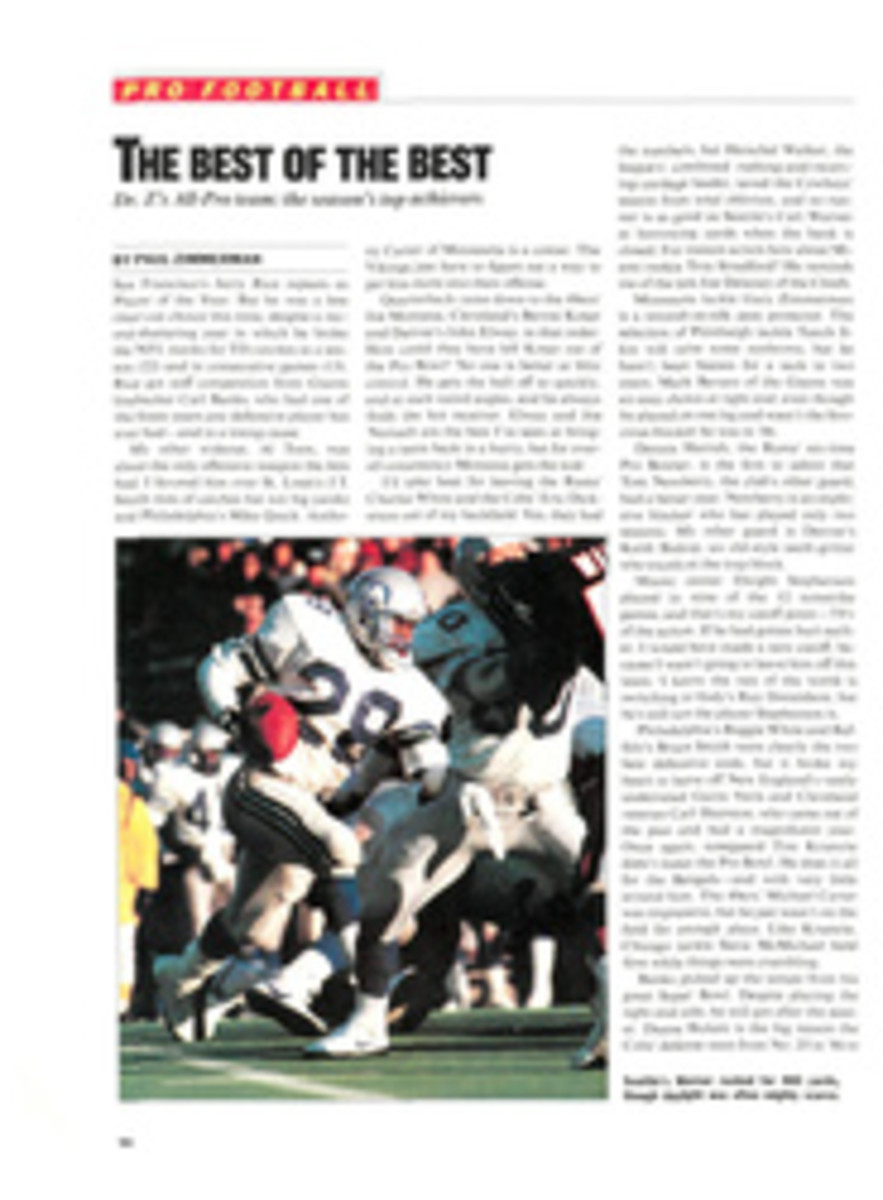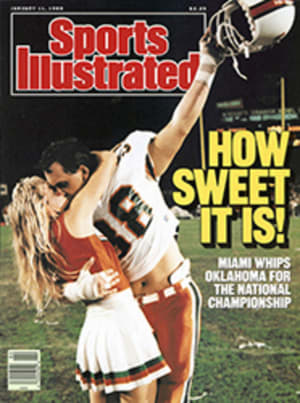
SCORECARD
THE VIEW FROM THE BENCH
Boosters and agents who give money to college athletes do so secure in the belief that, while such action violates NCAA rules, it's not against the law. But last month a U.S. District Court judge in White Plains, N.Y., delivered a sobering message to NCAA rule-breakers. In a ringing endorsement of amateurism in intercollegiate athletics, Chief Judge Charles L. Brieant made clear his view that, even in the absence of criminal or, to date, civil penalties in such cases, the court should not look kindly on under-the-table payments to college athletes.
Brieant delivered his surprisingly strong opinion in dismissing a $500,000 lawsuit filed by New York agents Norby Walters and Lloyd Bloom against former Auburn fullback Brent Fullwood, who had accepted $8,042 from Walters during his senior year but later bolted to another agent. Arguing that NCAA rules against professionalism are "rationally related to the commendable objective of protecting academic integrity of NCAA member institutions," Brieant wrote that "American colleges have struggled, with varying degrees of vigor, to protect the integrity of higher education from sports-related evils such as gambling, recruitment violations and the employment of mercenaries whose presence in college athletics programs will tend to preclude the participation of legitimate scholar athletes."
Although Fullwood, now with the Green Bay Packers, won in court, Brieant came down just as hard on him as he did on Walters and Bloom. "Both sides of the transaction knew exactly what they were doing, and they knew it was fraudulent and wrong," Brieant wrote. The secret deal between the two agents and the player, he added, "represented not only a betrayal of the high ideals that sustain amateur athletic competition as part of our national educational commitment; it also constituted a calculated fraud on the entire spectator public."
Brieant acknowledged that this public trust was "perhaps naive." But there was nothing naive about his conclusion that his court would not enforce a contract "between thieves."
THAT WAS SOME DRIVE
Golfer Greg Norman moved from Orlando to North Palm Beach, Fla., to be close to the ocean. After settling in, the man called the Shark took up scuba diving. On a recent dive in 40 feet of water a mile and a half from shore, he found a golf ball. Know anyone with an immense hook?
REEL NAMES
Among the anglers competing at the Red Man Regional Bass Classic on Lake Seminole in Georgia were Fred Guppy of Jacksonville, Ark., Johnny Bass of Lexington, N.C., and Mike Wurm from Hot Springs, Ark. Their names didn't help them much: Guppy finished 31st out of 101 entrants, Bass 21st and Wurm 18th.
JUST HAVING FUN
Remember Damon Bailey, the precocious eighth-grade hotshot who figured prominently in John Feinstein's A Season on the Brink, the 1987 best-seller about Indiana basketball coach Bob Knight and his team? Remember how, in Feinstein's account, a doting Knight journeyed 60 miles round-trip to take in one of Bailey's games and raved about the kid on the drive home?
Well, after leading Bedford North Lawrence High to the Indiana final four with a 23.8 average as a freshman last season, all Bailey, who's now 6'2", has done so far this season is score 31.3 points per game in leading the Stars to a 9-0 record. In a 70-65 defeat of New Albany on Dec. 15, Bailey had the best game of his brief career: He scored a school-record 43 points on 18-of-22 field goal shooting (he missed his first three tries and then made 18 in a row) and 6 for 6 from the line. He also had 10 rebounds and four steals.
Hoosier fans who envision Bailey in an Indiana uniform must wait to see if their dream will come true. "I just want to have fun playing for BNL for two more years," he says.
MARATHON BOWLING
William Taaffe, SI's TV critic, sat through 12 straight hours of college football telecasts on New Year's Day. His impressions:
Gayle Gardner. The first college football anchorwoman to appear on an over-the-air network—she came to NBC via ESPN—had a decidedly unsteady debut during the Orange Bowl telecast. She stumbled over names, botched the description of some half-time highlights and interviewed former Ohio State coach Earle Bruce without pressing him on the tension between scholarship and athletics. Opening night jitters? Probably. She knows sports and should improve.
Amen. NBC's Dick Enberg and Merlin Olsen cover the Rose Bowl as if it were a worship service. The weather, the grass, the tradition—all are described in reverent tones. You would think they were doing the Masters. Still, I like it, although I wish they would stop calling the goings-on in Pasadena the "granddaddy of the bowl games."
Journalism. At the Orange Bowl, NBC didn't allow Tom Hammond, who talked with Miami's embarrassingly evasive George Mira Jr., enough time to properly explain Mira's suspension from the roster for taking a diuretic. You can't reduce such a story to a quickie interview.
Sideline Announcers. They're out of control. Hammond, ABC's Mike Adamle and CBS's John Dockery all buttonholed interviewees while plays were occurring on the field. Sideline sleuths are fine at ferreting out news; for example, after the final gun at the Sugar Bowl, Adamle caught up with Auburn coach Pat Dye and asked why he went for a tie. But when the game is on, let's stay with it.
Camera Coverage. There were several memorable shots, topped by NBC director John Gonzalez's portrait of Miami coach Jimmy Johnson being carried off the Orange Bowl field, his arms pumping in silhouette against the night sky. But a number of key live shots were missed, notably Oklahoma's trick "fumblerooski" touchdown. Directors are developing myopia. The camera is so tight on the quarterback that all perspective is lost.
The Booth. Keith Jackson's confession on ABC that he would've gone for the tie in the Sugar Bowl was refreshingly candid. Jackson and his color-man, Bob Griese, best enhanced their game, although the intelligent Pat Haden of CBS was Griese's equal on analysis. NBC's Don Criqui and Bob Trumpy committed a cardinal sin by prematurely declaring Miami the Orange Bowl winner and national champion. Oklahoma's comeback fell short, saving them from a Dewey-defeats-Truman embarrassment.
TRUTH IN ADVERTISING
Miami coach Jimmy Johnson got the better of his Oklahoma counterpart, Barry Switzer, in the Orange Bowl (page 16), much as he seemingly had all season in an oft-telecast commercial for the VCR CFA College Bowl Game. At one point in the ad, Johnson grabs Switzer by the neck. "The producers said, 'Just do something that feels natural,' " says Johnson.
Johnson must be a natural actor. Not only is Switzer a close friend of his, but Johnson also recently allowed that he has never played College Bowl. He hastily added, "It looked interesting. It looked like a game you should play." Switzer and Johnson performed for a nominal fee as a favor to the College Football Association, which receives royalties for licensing the game.
AN ARTIST'S PORTRAIT OF AN ARTIST
Wayne Gretzky's worth as an Edmonton oiler is well established—his salary more than a million a year—and now we find that his value in the art market is nothing to sniff at, either. Consider the silk screen pictured below. It's by pop artist Andy Warhol, whose work—the portraits of Muhammad Ali and Marilyn Monroe, the soup cans, all of it—has soared in price since his death last February. The silk screen—one of 300 prints and six oils of Gretzky, wearing number 99, produced by Warhol and cosigned by Warhol and Gretzky—sold for $2,500 before Warhol died; now art dealer Frans Wynans of Vancouver is asking $6,000 for it.
The Gretzky works were the result of a 1984 meeting between Gretzky and Warhol at the latter's Manhattan studio, The Factory. Gretzky recalls an afternoon of "warm, lively conversation," unmarred by Warhol's unflinching allegiance to the New York Rangers. He also remembers that once it came time for posing, Warhol became dismayed that there wasn't a hockey stick around. So Wynans, who was present at the session, dashed to a sporting goods store across the street.
One of the oils hangs proudly in the dining room of Gretzky's Edmonton house. That painting, which was valued at $30,000 a year ago, would now carry a $100,000 price tag. To Gretzky, of course, it's priceless.
ILLUSTRATION
PATRICK McDONNELL
ILLUSTRATION
D. JAMES DEE
The silken skater's silken images have appreciated.
THEY SAID IT
•Erma Bombeck, syndicated columnist, explaining why she doesn't go downhill skiing: "I do not participate in any sport with ambulances at the bottom of the hill."
•Bill Raftery, former Seton Hall basketball coach and now an ESPN telecaster, expressing the view that a team is best served by a fat bus driver: "He knows the best ways to get in and out of tough places, and he always keeps ice in the cooler."

